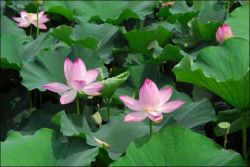Difference between revisions of "Xiaoshu"
imported>Superleila m (Created page with ''''Xiaoshu''' reflects the changing of temperature. Shu means heat in Chinese, and Xiaoshu means slight heat. == Weather: == At this time, the weather is getting hotter, but t...') |
imported>Ciic |
||
| (One intermediate revision by the same user not shown) | |||
| Line 1: | Line 1: | ||
| − | '''Xiaoshu''' reflects the changing of temperature. Shu means heat in Chinese, and Xiaoshu means slight heat. | + | [[file: Xiaoshu.JPEG|thumb|250px|left|the lotus pond in the Xiaoshu]] |
| + | '''Xiaoshu''' ('''小暑''') reflects the changing of temperature. Shu means heat in Chinese, and Xiaoshu means slight heat. | ||
== Weather: == | == Weather: == | ||
Latest revision as of 03:41, 9 July 2013
Xiaoshu (小暑) reflects the changing of temperature. Shu means heat in Chinese, and Xiaoshu means slight heat.
Weather:
At this time, the weather is getting hotter, but the temperature hasn't reached the highest degree. The daily average temperature in south China during Xiaoshu is around 26℃ (78.8oF) and in the river valley areas could be as high as 30℃ (86oF). The northern part of the northwest plateau, however, may still be covered with frost and snow.
Farming:
After Xiaoshu, most areas of China enter the rainy season, and crops grow quickly at this time. In some areas, such as the western part of south China, rainstorms, thunderstorms or even hailstones often come, causing floods and landslides. However, the eastern part of south China is often hit by drought, so people have to take measures to fight drought and prevent flood in the same period.
An old saying goes, "Southern wind on Xiaoshu leads to no rain on Dashu; thunder on Xiaoshu brings flood on Dashu."
